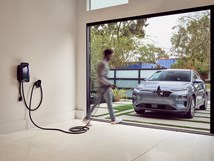VW Aero Car from the 1980s
Yes, it is highly aerodynamic. And for a car with 177 hp, fast. But not exactly the stuff of daily driving.
#aluminum #hybrid
Volkswagen engineers back in the 1980s wanted to see the effects of aero and mass on vehicle performance. Especially aero. Just look at this, the Aerodynamic Research Volkswagen (ARVW):

This is the ARVW, a study in aerodynamics by Volkswagen. (Images: VW)
The vehicle was built in 1980. It has a single seat. It is 33 inches tall and 43.3 inches wide.
There is an aluminum frame below the fiberglass and carbon-fiber composite skin.
Located behind the driver is a 2.4-liter turbocharged inline six that produces 177 hp. A chain drive powers the rear wheels.

One wonders: would a chiropractor be part of the development team?
There is a water tank that provided the fluid injected into the turbocharger intake. The primary engine cooling vent is in the nose and the air was expelled over the top of the vehicle.
The wheels are covered. The underbody is smooth. And there are moveable fins to help provide stability at speed.
The coefficient of drag of the ARVW is just 0.15.
A team of VW engineers and a professional driver went to the Nardo test track in Italy. It was October 1980. The car hit 221 mph during its first hour on the track.
They were able to get it up to a record-setting 225 mph.
The design of the ARVW was influential for that of the VW XL1, a limited-run production car (yes, a real car: I actually drove one in Wolfsburg, perhaps the one in this picture) that was rated at 261 mpg.

The very limited VW XL1 high-mileage hybrid vehicle of 2013.
Although the ARVW is certainly quick, it probably isn’t particularly comfortable.
RELATED CONTENT
-
Jaguar Land Rover & the Globalization of Auto
If you want a sense of the nature of the global nature of this business, consider last week’s announcement from Jaguar Land Rover.
-
Aluminum Sheet for EV Battery Enclosure
As the number of electric vehicles (EVs) is about to increase almost exponentially, aluminum supplier Novelis is preparing to provide customers with protective solutions
-
On French Concept, Inclusive Mobility, Nissan Frontier, and More
French conceptual mobility vehicles, VW addresses mobility for the disabled, a look at the 2022 Nissan Frontier, MINI surveys people about EVs, engineering the Sportster S engine, Honda’s avatar robot, and a driver shortage addressed


.jpg;width=70;height=70;mode=crop)






